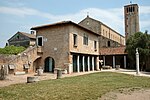National Archaeological Museum of Altino
1960 establishments in ItalyArchaeological museums in ItalyBuildings and structures in the Metropolitan City of VeniceMuseums established in 1960National museums of Italy

The National Archaeological Museum of Altino (in italian: Museo archeologico nazionale di Altino, MANA) is an archaeology museum next to the archaeological site of Altinum. It is located in the frazione Altino of the municipality of Quarto d'Altino, in the Metropolitan City of Venice. The museum, which preserves the most representative archaeological finds of Altinum, and the nearby archaeological site of Altino are included in the UNESCO World Heritage site "Venice and its lagoon".
Excerpt from the Wikipedia article National Archaeological Museum of Altino (License: CC BY-SA 3.0, Authors, Images).National Archaeological Museum of Altino
Via Sant'Eliodoro,
Geographical coordinates (GPS) Address Phone number Website Nearby Places Show on map
Geographical coordinates (GPS)
| Latitude | Longitude |
|---|---|
| N 45.5407 ° | E 12.3981 ° |
Address
Museo Archeologico Nazionale di Altino
Via Sant'Eliodoro 56
30020
Veneto, Italy
Open on Google Maps









